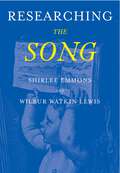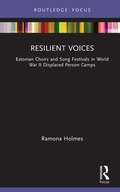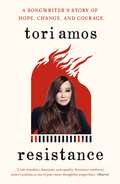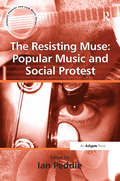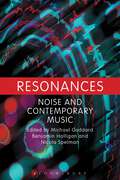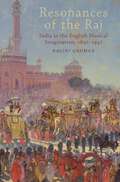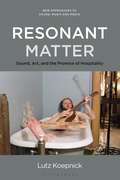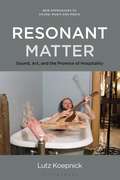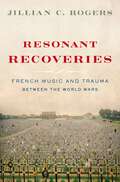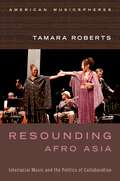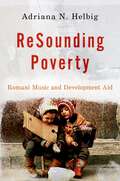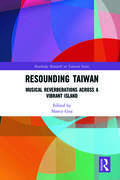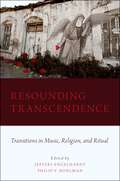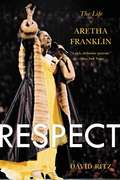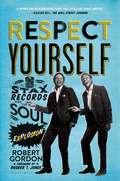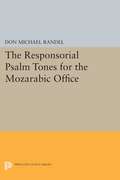- Table View
- List View
Researching the Song: A Lexicon
by Shirlee Emmons Wilbur Watkins LewisSingers are faced with a unique challenge among musicians: they must express not just the music, but the lyrics too. To effectively communicate the meaning behind these words, singers must understand the many references embedded in the vast international repertoire of great art songs. They must deal with the meaning of the lyrics, frequently in a language not their own and of a culture unfamiliar to them. From Zelter and Schubert to Rorem and Musto, Researching the Song serves as an invaluable guide for performers, teachers, and enthusiasts to the art song repertoire. Its more than 2,000 carefully researched entries supply information on most of the mythological, historical, geographical, and literary references contained in western art song. The authors explain the meaning of less familiar literary terms, figures, and authors referenced in song while placing songs in the context of larger literary sources. Readers will find entries dealing with art songs from the German, French, Italian, Russian, Spanish, South American, Greek, Finnish, Scandinavian, and both American and British English repertoires. Sources, narratives, and explanations of major song cycles are also given. Organized alphabetically, the lexicon includes brief biographies of poets, lists of composers who set each poet's work, bibliographic materials, and brief synopses of major works from which song texts were taken, including the plots of all Restoration theater works containing Purcell's vocal music. The more performers know and understand the literary elements of a song, the richer their communication will be. Researching the Song is a vital aid for singers and teachers in interpreting art songs and building song recital programs.
Resilient Voices: Estonian Choirs and Song Festivals in World War II Displaced Person Camps
by Ramona HolmesThe aftermath of World War II sent thousands of Estonian refugees into Europe. The years of Estonian independence (1917-1940) had given them a taste of freedom and so relocation to displaced person (DP) camps in post-war Germany was extremely painful. One way in which Estonians dealt with the chaos and trauma of WWII and its aftermath was through choral singing. Just as song festivals helped establish national identity in 1869, song festivals promoted cultural cohesiveness for Estonians in WWII displaced person camps. A key turning point in hope for the Estonian DPs was the 1947 Augsburg Song Festival, which is the center point of this book. As Estonian DPs dispersed to Australia, Canada, Europe, and the United States these choirs and song festivals gave Estonians the resilience to retain their identity and to thrive in their new homes. This history of Estonian WWII DP camp choirs and song festivals is gathered from the stories of many courageous individuals and filled with the tenacious spirit of the Estonian singing culture. This work contributes to an understanding of immigration, identity, and resilience and is particularly important within the field of music regarding music and healing, music and identity, historical musicology, ethnomusicology, and music and politics.
Resilient Voices: Estonian Choirs and Song Festivals in World War II Displaced Person Camps
by Ramona HolmesThe aftermath of World War II sent thousands of Estonian refugees into Europe. The years of Estonian independence (1917-1940) had given them a taste of freedom and so relocation to displaced person (DP) camps in post-war Germany was extremely painful. One way in which Estonians dealt with the chaos and trauma of WWII and its aftermath was through choral singing. Just as song festivals helped establish national identity in 1869, song festivals promoted cultural cohesiveness for Estonians in WWII displaced person camps. A key turning point in hope for the Estonian DPs was the 1947 Augsburg Song Festival, which is the center point of this book. As Estonian DPs dispersed to Australia, Canada, Europe, and the United States these choirs and song festivals gave Estonians the resilience to retain their identity and to thrive in their new homes. This history of Estonian WWII DP camp choirs and song festivals is gathered from the stories of many courageous individuals and filled with the tenacious spirit of the Estonian singing culture. This work contributes to an understanding of immigration, identity, and resilience and is particularly important within the field of music regarding music and healing, music and identity, historical musicology, ethnomusicology, and music and politics.
Resistance: A Songwriter’s Story of Hope, Change and Courage
by Tori AmosSince the release of her first, career-defining solo album Little Earthquakes, Tori Amos has been one of the music industry's most enduring and ingenious artists. From her unnerving depiction of sexual assault in "Me and a Gun" to her post-9/11 album Scarlet's Walk to her latest album Native Invader, her work has never shied away from intermingling the personal with the political. Amos began playing piano as a teenager for the politically powerful at hotel bars in Washington, D.C., during the formative years of the post-Goldwater and then Koch-led Libertarian and Reaganite movements. The story continues to her time as a hungry artist in L.A. to the subsequent three decades of her formidable music career. Amos explains how she managed to create meaningful, politically resonant work against patriarchal power structures-and how her proud declarations of feminism and her fight for the marginalized always proved to be her guiding light. She teaches readers to engage with intention in this tumultuous global climate and speaks directly to supporters of #MeToo and #TimesUp, as well as young people fighting for their rights and visibility in the world. Filled with compassionate guidance and actionable advice-and using some of the most powerful, political songs in Amos's canon-this book is for readers determined to steer the world back in the right direction.
The Resisting Muse: Popular Music and Social Protest (Ashgate Popular and Folk Music Series)
by Ian PeddiePopular music has traditionally served as a rallying point for voices of opposition, across a huge variety of genres. This volume examines the various ways popular music has been deployed as anti-establishment and how such opposition both influences and responds to the music produced. Implicit in the notion of resistance is a broad adversarial hegemony against which opposition is measured. But it would be wrong to regard the music of popular protest as a kind of dialogue in league against 'the establishment'. Convenient though they are, such 'us and them' arguments bespeak a rather shop-worn stance redolent of youthful rebellion. It is much more fruitful to perceive the relationship as a complex dialectic where musical protest is as fluid as the audiences to which it appeals and the hegemonic structures it opposes. The book's contemporary focus (largely post-1975) allows for comprehensive coverage of extremely diverse forms of popular music in relation to the creation of communities of protest. Because such communities are fragmented and diverse, the shared experience and identity popular music purports is dependent upon an audience collectivity that is now difficult to presume. In this respect, The Resisting Muse examines how the forms and aims of social protest music are contingent upon the audience's ability to invest the music with the 'appropriate' political meaning. Amongst a plethora of artists, genres, and themes, highlights include discussions of Aboriginal rights and music, Bauhaus, Black Sabbath, Billy Bragg, Bono, Cassette culture, The Capitol Steps, Class, The Cure , DJ Spooky, Drum and Bass, Eminem, Farm Aid, Foxy Brown, Folk, Goldie, Gothicism, Woody Guthrie, Heavy Metal, Hip-hop, Independent/home publishing, Iron Maiden, Joy Division, Jungle, Led Zeppelin, Lil'Kim, Live Aid, Marilyn Manson, Bob Marley, MC Eiht, Minor Threat, Motown, Queen Latifah, Race, Rap, Rastafarianism, Reggae, The Roots, Diana Ross, Rush, Salt-n-Pepa, 7 Seconds, Roxanne Shanté, Siouxsie and the Banshees, The Sisters of Mercy, Michelle Shocked, Bessie Smith, Straight edge Sunrize Band, Bunny Wailer, Wilco, Bart Willoughby, Wirrinyga Band, Zines.
The Resisting Muse: Popular Music and Social Protest (Ashgate Popular and Folk Music Series)
by Ian PeddiePopular music has traditionally served as a rallying point for voices of opposition, across a huge variety of genres. This volume examines the various ways popular music has been deployed as anti-establishment and how such opposition both influences and responds to the music produced. Implicit in the notion of resistance is a broad adversarial hegemony against which opposition is measured. But it would be wrong to regard the music of popular protest as a kind of dialogue in league against 'the establishment'. Convenient though they are, such 'us and them' arguments bespeak a rather shop-worn stance redolent of youthful rebellion. It is much more fruitful to perceive the relationship as a complex dialectic where musical protest is as fluid as the audiences to which it appeals and the hegemonic structures it opposes. The book's contemporary focus (largely post-1975) allows for comprehensive coverage of extremely diverse forms of popular music in relation to the creation of communities of protest. Because such communities are fragmented and diverse, the shared experience and identity popular music purports is dependent upon an audience collectivity that is now difficult to presume. In this respect, The Resisting Muse examines how the forms and aims of social protest music are contingent upon the audience's ability to invest the music with the 'appropriate' political meaning. Amongst a plethora of artists, genres, and themes, highlights include discussions of Aboriginal rights and music, Bauhaus, Black Sabbath, Billy Bragg, Bono, Cassette culture, The Capitol Steps, Class, The Cure , DJ Spooky, Drum and Bass, Eminem, Farm Aid, Foxy Brown, Folk, Goldie, Gothicism, Woody Guthrie, Heavy Metal, Hip-hop, Independent/home publishing, Iron Maiden, Joy Division, Jungle, Led Zeppelin, Lil'Kim, Live Aid, Marilyn Manson, Bob Marley, MC Eiht, Minor Threat, Motown, Queen Latifah, Race, Rap, Rastafarianism, Reggae, The Roots, Diana Ross, Rush, Salt-n-Pepa, 7 Seconds, Roxanne Shanté, Siouxsie and the Banshees, The Sisters of Mercy, Michelle Shocked, Bessie Smith, Straight edge Sunrize Band, Bunny Wailer, Wilco, Bart Willoughby, Wirrinyga Band, Zines.
Resonances: Noise and Contemporary Music
by Michael Goddard Benjamin Halligan Nicola SpelmanResonances is a compelling collection of new essays by scholars, writers and musicians, all seeking to explore and enlighten this field of study. Noise seems to stand for a lack of aesthetic grace, to alienate or distract rather than enrapture. And yet the drones of psychedelia, the racket of garage rock and punk, the thudding of rave, the feedback of shoegaze and post-rock, the bombast of thrash and metal, the clatter of jungle and the stuttering of electronica, together with notable examples of avant-garde noise art, have all found a place in the history of contemporary musics, and are recognised as representing key evolutionary moments. Noise therefore is the untold story of contemporary popular music, and in a critical exploration of noise lies the possibility of a new narrative: one that is wide-ranging, connects the popular to the underground and avant-garde, fully posits the studio as a musical instrument, and demands new critical and theoretical paradigms of those seeking to write about music.
Resonances: Noise and Contemporary Music
by Michael Goddard Benjamin Halligan Nicola SpelmanResonances is a compelling collection of new essays by scholars, writers and musicians, all seeking to explore and enlighten this field of study. Noise seems to stand for a lack of aesthetic grace, to alienate or distract rather than enrapture. And yet the drones of psychedelia, the racket of garage rock and punk, the thudding of rave, the feedback of shoegaze and post-rock, the bombast of thrash and metal, the clatter of jungle and the stuttering of electronica, together with notable examples of avant-garde noise art, have all found a place in the history of contemporary musics, and are recognised as representing key evolutionary moments. Noise therefore is the untold story of contemporary popular music, and in a critical exploration of noise lies the possibility of a new narrative: one that is wide-ranging, connects the popular to the underground and avant-garde, fully posits the studio as a musical instrument, and demands new critical and theoretical paradigms of those seeking to write about music.
Resonances of the Raj: India in the English Musical Imagination,1897-1947
by Nalini GhumanDuring the century of British rule of the Indian subcontinent known as the British Raj, the rulers felt the significant influence of their exotic subjects. Resonances of the Raj examines the ramifications of the intertwined and overlapping histories of Britain and India on English music in the last fifty years of the colonial encounter, and traces the effects of the Raj on the English musical imagination. Conventional narratives depict a one-way influence of Britain on India, with the 'discovery' of Indian classical music occurring only in the post-colonial era. Drawing on new archival sources and approaches in cultural studies, author Nalini Ghuman shows that on the contrary, England was both deeply aware of and heavily influenced by India musically during the Indian-British colonial encounter. Case studies of representative figures, including composers Edward Elgar and Gustav Holst, and Maud MacCarthy, an ethnomusicologist and performer of the era, integrate music directly into the cultural history of the British Raj. Ghuman thus reveals unexpected minglings of peoples, musics and ideas that raise questions about 'Englishness', the nature of Empire, and the fixedness of identity. Richly illustrated with analytical music examples and archival photographs and documents, many of which appear here in print for the first time, Resonances of the Raj brings fresh hearings to both familiar and little-known musics of the time, and reveals a rich and complex history of cross-cultural musical imaginings which leads to a reappraisal of the accepted historiographies of both British musical culture and of Indo-Western fusion.
Resonant Matter: Sound, Art, and the Promise of Hospitality (New Approaches to Sound, Music, and Media)
by Lutz KoepnickIn Resonant Matter, Lutz Koepnick considers contemporary sound and installation art as a unique laboratory of hospitality amid inhospitable times. Inspired by Ragnar Kjartansson's nine-channel video installation The Visitors (2012), the book explores resonance-the ability of objects to be affected by the vibrations of other objects-as a model of art's fleeting promise to make us coexist with things strange and other. In a series of nuanced readings, Koepnick follows the echoes of distant, unexpected, and unheard sounds in twenty-first century art to reflect on the attachments we pursue to sustain our lives and the walls we need to tear down to secure possible futures. The book's nine chapters approach The Visitors from ever-different conceptual angles while bringing it into dialogue with the work of other artists and musicians such as Lawrence Abu Hamdan, Guillermo Galindo, Mischa Kuball, Philipp Lachenmann, Alvien Lucier, Teresa Margolles, Carsten Nicolai, Camille Norment, Susan Philipsz, David Rothenberg, Juliana Snapper, and Tanya Tagaq. With this book, Koepnick situates resonance as a vital concept of contemporary art criticism and sound studies. His analysis encourages us not only to expand our understanding of the role of sound in art, of sound art, but to attune our critical encounter with art to art's own resonant thinking.
Resonant Matter: Sound, Art, and the Promise of Hospitality (New Approaches to Sound, Music, and Media)
by Lutz KoepnickIn Resonant Matter, Lutz Koepnick considers contemporary sound and installation art as a unique laboratory of hospitality amid inhospitable times. Inspired by Ragnar Kjartansson's nine-channel video installation The Visitors (2012), the book explores resonance-the ability of objects to be affected by the vibrations of other objects-as a model of art's fleeting promise to make us coexist with things strange and other. In a series of nuanced readings, Koepnick follows the echoes of distant, unexpected, and unheard sounds in twenty-first century art to reflect on the attachments we pursue to sustain our lives and the walls we need to tear down to secure possible futures. The book's nine chapters approach The Visitors from ever-different conceptual angles while bringing it into dialogue with the work of other artists and musicians such as Lawrence Abu Hamdan, Guillermo Galindo, Mischa Kuball, Philipp Lachenmann, Alvien Lucier, Teresa Margolles, Carsten Nicolai, Camille Norment, Susan Philipsz, David Rothenberg, Juliana Snapper, and Tanya Tagaq. With this book, Koepnick situates resonance as a vital concept of contemporary art criticism and sound studies. His analysis encourages us not only to expand our understanding of the role of sound in art, of sound art, but to attune our critical encounter with art to art's own resonant thinking.
Resonant Recoveries: French Music and Trauma Between the World Wars
by Jillian C. RogersCoping with trauma and the losses of World War I was a central concern for French musicians in the interwar period. Almost all of them were deeply affected by the war as they fought in the trenches, worked in military hospitals, or mourned a friend or relative who had been wounded, killed, or taken prisoner. In Resonant Recoveries, author Jillian C. Rogers argues that French modernist composers processed this experience of unprecedented violence by turning their musical activities into locations for managing and performing trauma. Through analyses of archival materials, French medical, philosophical, and literary texts, and the music produced between the wars, Rogers frames World War I as a pivotal moment in the history of music therapy. When musicians and their audiences used music to remember lost loved ones, perform grief, create healing bonds of friendship, and find consolation in soothing sonic vibrations and rhythmic bodily movements, they reconfigured music into an embodied means of consolation--a healer of wounded minds and bodies. This in-depth account of the profound impact that postwar trauma had on French musical life makes a powerful case for the importance of addressing trauma, mourning, and people's emotional lives in music scholarship. This is an open access title available under the terms of a CC BY-NC-ND 4.0 licence. It is free to read at Oxford Scholarship Online and offered as a free PDF download from OUP and selected open access locations.
Resonant Recoveries: French Music and Trauma Between the World Wars
by Jillian C. RogersCoping with trauma and the losses of World War I was a central concern for French musicians in the interwar period. Almost all of them were deeply affected by the war as they fought in the trenches, worked in military hospitals, or mourned a friend or relative who had been wounded, killed, or taken prisoner. In Resonant Recoveries, author Jillian C. Rogers argues that French modernist composers processed this experience of unprecedented violence by turning their musical activities into locations for managing and performing trauma. Through analyses of archival materials, French medical, philosophical, and literary texts, and the music produced between the wars, Rogers frames World War I as a pivotal moment in the history of music therapy. When musicians and their audiences used music to remember lost loved ones, perform grief, create healing bonds of friendship, and find consolation in soothing sonic vibrations and rhythmic bodily movements, they reconfigured music into an embodied means of consolation--a healer of wounded minds and bodies. This in-depth account of the profound impact that postwar trauma had on French musical life makes a powerful case for the importance of addressing trauma, mourning, and people's emotional lives in music scholarship. This is an open access title available under the terms of a CC BY-NC-ND 4.0 licence. It is free to read at Oxford Scholarship Online and offered as a free PDF download from OUP and selected open access locations.
Resounding Afro Asia: Interracial Music and the Politics of Collaboration (American Musicspheres)
by Tamara RobertsCultural hybridity is a celebrated hallmark of U.S. American music and identity. Yet hybrid music is all too often marked -and marketed - under a single racial label. Resounding Afro Asia examines music projects that counter this convention; these projects instead foreground racial mixture in players, audiences, and sound in the very face of the ghettoizing culture industry. Giving voice to four contemporary projects, author Tamara Roberts traces black/Asian engagements that reach across the United States and beyond: Funkadesi, Yoko Noge, Fred Ho and the Afro Asian Music Ensemble, and Red Baraat. From Indian funk & reggae, to Japanese folk & blues, to jazz in various Asian and African traditions, to Indian brass band and New Orleans second line, these artists live multiracial lives in which they inhabit - and yet exceed - multicultural frameworks built on essentialism and segregation. When these musicians collaborate, they generate and perform racially marked sounds that do not conform to their individual racial identities. The Afro Asian artists discussed in this book splinter the expectations of racial determinism, and through improvisation and composition, articulate new identities and subjectivities in conversation with each other. These dynamic social, aesthetic, and sonic practices construct a forum for the negotiation of racial and cultural difference and the formation of inter-minority solidarities. Resounding Afro Asia joins a growing body of literature that is writing Asian American artists back into U.S. popular music history, while highlighting interracial engagements that have fueled U.S. music making. The book will appeal to scholars of music, ethnomusicology, race theory, and politics, as well as those interested in race and popular music.
RESOUNDING AFRO ASIA AM C: Interracial Music and the Politics of Collaboration (American Musicspheres)
by Tamara RobertsCultural hybridity is a celebrated hallmark of U.S. American music and identity. Yet hybrid music is all too often marked -and marketed - under a single racial label. Resounding Afro Asia examines music projects that counter this convention; these projects instead foreground racial mixture in players, audiences, and sound in the very face of the ghettoizing culture industry. Giving voice to four contemporary projects, author Tamara Roberts traces black/Asian engagements that reach across the United States and beyond: Funkadesi, Yoko Noge, Fred Ho and the Afro Asian Music Ensemble, and Red Baraat. From Indian funk & reggae, to Japanese folk & blues, to jazz in various Asian and African traditions, to Indian brass band and New Orleans second line, these artists live multiracial lives in which they inhabit - and yet exceed - multicultural frameworks built on essentialism and segregation. When these musicians collaborate, they generate and perform racially marked sounds that do not conform to their individual racial identities. The Afro Asian artists discussed in this book splinter the expectations of racial determinism, and through improvisation and composition, articulate new identities and subjectivities in conversation with each other. These dynamic social, aesthetic, and sonic practices construct a forum for the negotiation of racial and cultural difference and the formation of inter-minority solidarities. Resounding Afro Asia joins a growing body of literature that is writing Asian American artists back into U.S. popular music history, while highlighting interracial engagements that have fueled U.S. music making. The book will appeal to scholars of music, ethnomusicology, race theory, and politics, as well as those interested in race and popular music.
ReSounding Poverty: Romani Music and Development Aid
by Adriana N. HelbigReSounding Poverty: Romani Music and Development Aid engages with global scholarship on development, poverty, and applied research. It addresses the role of non-governmental organizations (NGOs) within postsocialist neoliberal processes and analyzes the economic structures within which Romani musics circulate. Specifically, ReSounding Poverty offers a micro ethnography of economic networks that impact the daily lives of Romani musicians on the borders of the former Soviet Union and the European Union. It argues that the development aid allotted to provide economic assistance to Romani communities, when analyzed from the perspective of the performance arts, continues to marginalize the poorest among them. Through their structure and programming, NGOs choose which segments of the population are the most vulnerable and in the greatest need of assistance. Drawing on ethnographic research in development contexts, ReSounding Poverty asks who speaks for whom within the Romani rights movement today. Framing the critique of development aid in musical terms, it engages with Romani marginalization and economic deprivation through a closer listening to vocal inflections, physical vocalizations of health and disease, and emotional affect. ReSounding Poverty brings us into the back rooms of saman, mud and straw brick, houses not visited by media reporters and politicians, amplifying the cultural expressions of the Romani poor, silenced in the business of development.
ReSounding Poverty: Romani Music and Development Aid
by Adriana N. HelbigReSounding Poverty: Romani Music and Development Aid engages with global scholarship on development, poverty, and applied research. It addresses the role of non-governmental organizations (NGOs) within postsocialist neoliberal processes and analyzes the economic structures within which Romani musics circulate. Specifically, ReSounding Poverty offers a micro ethnography of economic networks that impact the daily lives of Romani musicians on the borders of the former Soviet Union and the European Union. It argues that the development aid allotted to provide economic assistance to Romani communities, when analyzed from the perspective of the performance arts, continues to marginalize the poorest among them. Through their structure and programming, NGOs choose which segments of the population are the most vulnerable and in the greatest need of assistance. Drawing on ethnographic research in development contexts, ReSounding Poverty asks who speaks for whom within the Romani rights movement today. Framing the critique of development aid in musical terms, it engages with Romani marginalization and economic deprivation through a closer listening to vocal inflections, physical vocalizations of health and disease, and emotional affect. ReSounding Poverty brings us into the back rooms of saman, mud and straw brick, houses not visited by media reporters and politicians, amplifying the cultural expressions of the Romani poor, silenced in the business of development.
Resounding Taiwan: Musical Reverberations Across a Vibrant Island (Routledge Research on Taiwan Series)
by Nancy GuyThis book vibrantly demonstrates how the study of music allows for identification and interpretation of the forces that form Taiwanese society, from politics and policy to reactions to and assertions of such policies. Contributors to this edited volume explore how music shapes life — and life shapes music — in Taiwan, focusing on subjects ranging from musical life under Japanese colonial rule (1895–1945) through to the contemporary creations of Indigenous musicians, popular music performance and production, Christian religious music, traditional ritual music and theatre, conceptions about sound and noise, and garbage truck music's role in reducing household waste. The volume’s twelve chapters present diverse approaches to their sounding subjects, some deeply rooted in the methods and concerns explored by Taiwan's first generation of ethnomusicologists. Others employ current social theories. Presenting a window into the cultural lives of the residents of this multicultural, politically contested island, Resounding Taiwan will appeal to students and scholars of musicology and ethnomusicology, anthropology and Asian studies more widely.
Resounding Taiwan: Musical Reverberations Across a Vibrant Island (Routledge Research on Taiwan Series)
by Nancy GuyThis book vibrantly demonstrates how the study of music allows for identification and interpretation of the forces that form Taiwanese society, from politics and policy to reactions to and assertions of such policies. Contributors to this edited volume explore how music shapes life — and life shapes music — in Taiwan, focusing on subjects ranging from musical life under Japanese colonial rule (1895–1945) through to the contemporary creations of Indigenous musicians, popular music performance and production, Christian religious music, traditional ritual music and theatre, conceptions about sound and noise, and garbage truck music's role in reducing household waste. The volume’s twelve chapters present diverse approaches to their sounding subjects, some deeply rooted in the methods and concerns explored by Taiwan's first generation of ethnomusicologists. Others employ current social theories. Presenting a window into the cultural lives of the residents of this multicultural, politically contested island, Resounding Taiwan will appeal to students and scholars of musicology and ethnomusicology, anthropology and Asian studies more widely.
Resounding Transcendence: Transitions in Music, Religion, and Ritual
by Jeffers Engelhardt Philip BohlmanResounding Transcendence is a pathbreaking set of ethnographic and historical essays by leading scholars exploring the ways sacred music effects cultural, political, and religious transitions in the contemporary world. With chapters covering Christian, Muslim, Jewish, and Buddhist practices in East and Southeast Asia, the Indian subcontinent, North America, the Caribbean, North Africa, and Europe, the volume establishes the theoretical and methodological foundations for music scholarship to engage in current debates about modern religion and secular epistemologies. It also transforms those debates through sophisticated, nuanced treatments of sound and music - ubiquitous elements of ritual and religion often glossed over in other disciplines. Resounding Transcendence confronts the relationship of sound, divinity, and religious practice in diverse post-secular contexts. By examining the immanence of transcendence in specific social and historical contexts and rethinking the reified nature of "religion" and "world religions," these authors examine the dynamics of difference and transition within and between sacred musical practices. The work in this volume transitions between traditional spaces of sacred musical practice and emerging public spaces for popular religious performance; between the transformative experience of ritual and the sacred musical affordances of media technologies; between the charisma of individual performers and the power of the marketplace; and between the making of authenticity and hybridity in religious repertoires and practices. Broad in scope, rich in ethnographic and historical detail, and theoretically ambitious, Resounding Transcendence is an essential contribution to the study of music and religion.
RESOUNDING TRANSCENDENCE C: Transitions in Music, Religion, and Ritual
by Jeffers Engelhardt and Philip V. BohlmanResounding Transcendence is a pathbreaking set of ethnographic and historical essays by leading scholars exploring the ways sacred music effects cultural, political, and religious transitions in the contemporary world. With chapters covering Christian, Muslim, Jewish, and Buddhist practices in East and Southeast Asia, the Indian subcontinent, North America, the Caribbean, North Africa, and Europe, the volume establishes the theoretical and methodological foundations for music scholarship to engage in current debates about modern religion and secular epistemologies. It also transforms those debates through sophisticated, nuanced treatments of sound and music - ubiquitous elements of ritual and religion often glossed over in other disciplines. Resounding Transcendence confronts the relationship of sound, divinity, and religious practice in diverse post-secular contexts. By examining the immanence of transcendence in specific social and historical contexts and rethinking the reified nature of "religion" and "world religions," these authors examine the dynamics of difference and transition within and between sacred musical practices. The work in this volume transitions between traditional spaces of sacred musical practice and emerging public spaces for popular religious performance; between the transformative experience of ritual and the sacred musical affordances of media technologies; between the charisma of individual performers and the power of the marketplace; and between the making of authenticity and hybridity in religious repertoires and practices. Broad in scope, rich in ethnographic and historical detail, and theoretically ambitious, Resounding Transcendence is an essential contribution to the study of music and religion.
Respect: The Life of Aretha Franklin
by David RitzThe definitive biography of the Queen of Soul from acclaimed music writer David Ritz. Aretha Franklin began life as the golden daughter of a progressive and promiscuous Baptist preacher. Raised without her mother, she was a gospel prodigy who gave birth to two sons in her teens and left them and her native Detroit for New York, where she struggled to find her true voice. It was not until 1967, when a white Jewish producer insisted she return to her gospel-soul roots, that fame and fortune finally came via "Respect" and a rapidfire string of hits. She has evolved ever since, amidst personal tragedy, surprise Grammy performances, and career reinventions. Again and again, Aretha stubbornly finds a way to triumph over troubles, even as they continue to build. Her hold on the crown is tenacious, and in Respect, David Ritz gives us the definitive life of one of the greatest talents in all American culture.
Respect Yourself: Stax Records and the Soul Explosion
by Robert GordonThe story of Stax Records unfolds like a Greek tragedy. A white brother and sister build a record company that becomes a monument to racial harmony in 1960's segregated south Memphis. Their success is startling, and Stax soon defines an international sound. Then, after losses both business and personal, the siblings part, and the brother allies with a visionary African-American partner. Under integrated leadership, Stax explodes as a national player until, Icarus-like, they fall from great heights to a tragic demise. Everything is lost, and the sanctuary that flourished is ripped from the ground. A generation later, Stax is rebuilt brick by brick to once again bring music and opportunity to the people of Memphis. Set in the world of 1960s and '70s soul music, Respect Yourself is a story of epic heroes in a shady industry. It's about music and musicians -- Isaac Hayes, Otis Redding, Sam and Dave, Wilson Pickett, the Staple Singers, and Booker T. and the M.G.'s, Stax's interracial house band. It's about a small independent company's struggle to survive in a business world of burgeoning conglomerates. And always at the center of the story is Memphis, Tennessee, an explosive city struggling through heated, divisive years. Told by one of our leading music chroniclers, Respect Yourself brings to life this treasured cultural institution and the city that created it.
The Responsorial Psalm Tones for the Mozarabic Office
by Don Michael RandelThis definitive study takes as its subject a group of melodies copied many times, even within single manuscripts. Professor Randel is therefore able to base his conclusions about the relationship of the manuscript sources to one another on twenty-six separate Spanish manuscripts. He shows that there were actually four distinct traditions associated with these manuscripts instead of two as formerly assumed. By comparing the four traditions, he draws new conclusions about the relative antiquity of the written tradition for these psalm tones, the presence or absence of a modal system in the Mozarabic chant, and the development of the two general types of notation.Originally published in 1969.The Princeton Legacy Library uses the latest print-on-demand technology to again make available previously out-of-print books from the distinguished backlist of Princeton University Press. These editions preserve the original texts of these important books while presenting them in durable paperback and hardcover editions. The goal of the Princeton Legacy Library is to vastly increase access to the rich scholarly heritage found in the thousands of books published by Princeton University Press since its founding in 1905.
